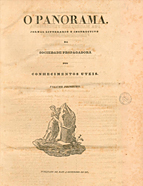

................................
The impact of O Panorama was so significant that it continued to be remembered by Portuguese cultural figures long after its extinction. As António Manuel Ribeiro aptly observed, this popular newspaper of the 1830s was viewed with admiration and respect by thinkers such as Ramalho Ortigão, Joaquim de Araújo, Teófilo Braga, Sampaio Bruno, and Oliveira Martins. O Panorama even earned mentions in 19th-century fiction, including works like Eusébio Macário by Camilo Castelo Branco and A Ilustre Casa de Ramires [The Illustrious House of Ramires] by Eça de Queiroz ( O periodismo cientifico e literário Romântico [Romantic scientific and literary journalism], pp. 74-75).
Representing an ideal, the newspaper set a benchmark for its era and became a model for other publications. Today, O Panorama remains a rich historical source for research in diverse fields such as history, literature, journalism, and Romanticism. Even with modern access to information, this newspaper still stands as a fascinating and valuable resource due to its thematic diversity.
Sources: (1837-68) Estatutos da Sociedade Propagadora de Conhecimentos Úteis . Lisboa, Imprensa Nacional/Sociedade Propagadora de Conhecimentos Úteis, 1837.
Bibliography: BAPTISTA, Jacinto, Alexandre Herculano, jornalista , Amadora , Bertrand, 1977; CATROGA, Fernando, «Romantismo, literatura e história», in História de Portugal (coord. Luís Reis Torgal e João Lourenço Roque), vol. V, Circulo de Leitores, 1993, pp. 545-561; «Alexandre Herculano e o historicismo romântico», in TORGAL, Luís Reis, MENDES, José Amada, CATROGA, Fernando, in TORGAL et alia, História da História em Portugal, séculos XIX-XX , Círculo de Leitores, pp. 39-85; MATOS, Sérgio Campos, Historiografia e memória nacional no Portugal do século XIX : 1846-1898 , Lisboa, Colibri, 1998,
This work is financed by national funds through FCT - Foundation for Science and Technology, I.P, in the scope of the projects UIDB/04311/2020 and UIDP/04311/2020.
